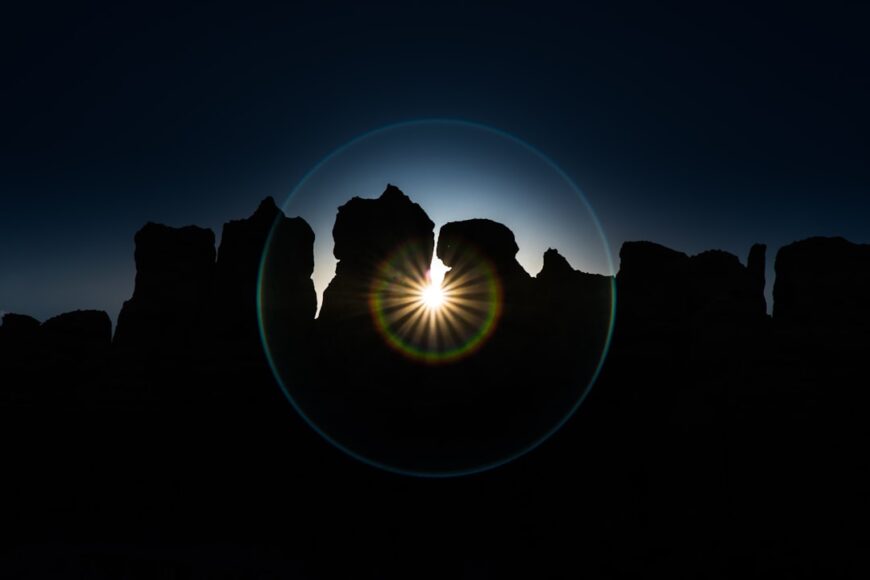
A total solar eclipse is a rare and awe-inspiring event that occurs when the moon passes between the sun and the Earth, blocking out the sun’s light and casting a shadow on the Earth’s surface. This phenomenon is a breathtaking display of nature’s power and beauty, and it has captivated humans for centuries. Viewing a total solar eclipse is not only a once-in-a-lifetime experience, but it also provides an opportunity to witness and appreciate the wonders of our universe.
Understanding the Total Solar Eclipse Phenomenon
A total solar eclipse occurs when the moon aligns perfectly with the sun and Earth, casting a shadow on the Earth’s surface. This alignment is rare because the moon’s orbit around the Earth is tilted relative to the Earth’s orbit around the sun. As a result, most of the time, the moon passes above or below the sun from our perspective on Earth. However, when the moon’s orbit intersects with the Earth’s orbit at just the right angle, a total solar eclipse occurs.
Total solar eclipses are rare events because they require precise alignment of the sun, moon, and Earth. On average, a total solar eclipse can be seen from any given location on Earth once every 375 years. However, some regions may experience more frequent eclipses due to their geographical location. For example, parts of South America will experience two total solar eclipses within a span of just seven years in 2019 and 2026.
Throughout history, total solar eclipses have held great significance for various cultures and civilizations. Ancient civilizations often interpreted eclipses as omens or signs from the gods. In modern times, scientists have used total solar eclipses as opportunities to study and learn more about our universe. These events provide valuable insights into the workings of our solar system and have contributed to advancements in astronomy and astrophysics.
Best Places to View the Total Solar Eclipse in 2024
The total solar eclipse on April 8, 2024, will be visible across a large portion of North America. Some of the best places to view this eclipse include cities such as Dallas, Texas; Indianapolis, Indiana; and Buffalo, New York. These locations offer a high probability of clear skies and optimal viewing conditions.
Choosing the best location for viewing a total solar eclipse depends on several factors. One important consideration is the weather. Clear skies are essential for a successful viewing experience, so it is crucial to research the historical weather patterns of potential viewing locations. Additionally, accessibility and accommodations should be taken into account when planning your trip. It is advisable to choose a location that is easily accessible and has sufficient lodging options.
Planning Your Trip for the Total Solar Eclipse
Planning your trip for the total solar eclipse requires careful consideration and preparation. One of the first steps is to book accommodations and transportation well in advance. Due to the popularity of total solar eclipses, hotels and rental properties in prime viewing locations tend to fill up quickly. It is recommended to make reservations as soon as possible to secure your spot.
When packing for your trip, it is essential to bring the necessary equipment for viewing the eclipse safely. This includes solar viewing glasses or filters, which protect your eyes from the harmful rays of the sun. It is crucial to purchase certified glasses or filters from reputable sources to ensure their effectiveness. Additionally, bringing a camera or video equipment can allow you to capture this extraordinary event and share it with others.
Safety Tips for Viewing the Total Solar Eclipse
Viewing a total solar eclipse without proper precautions can be dangerous and potentially harmful to your eyesight. Looking directly at the sun during an eclipse can cause permanent damage to your eyes, even if it is only for a few seconds. Therefore, it is crucial to take safety precautions when observing this phenomenon.
The most important safety tip is to never look directly at the sun without proper eye protection. Regular sunglasses are not sufficient for viewing a solar eclipse. Instead, use certified solar viewing glasses or filters that meet the necessary safety standards. These glasses are specifically designed to block out the harmful rays of the sun and allow you to view the eclipse safely.
In case of an emergency, it is essential to have a plan in place. Make sure you are familiar with the location and have a way to communicate with others. It is also advisable to have a first aid kit on hand in case of any minor injuries or accidents. If you experience any discomfort or vision problems during the eclipse, seek medical attention immediately.
Equipment Needed for Viewing the Total Solar Eclipse
To view a total solar eclipse safely and effectively, certain equipment is necessary. The most important piece of equipment is certified solar viewing glasses or filters. These glasses are specially designed to protect your eyes from the harmful rays of the sun and allow you to view the eclipse without damaging your eyesight.
In addition to solar viewing glasses, a camera or video equipment can enhance your viewing experience and allow you to capture this extraordinary event. When choosing a camera, consider its capabilities for capturing high-quality images or videos of the eclipse. It is also important to have a tripod or stabilizer to ensure steady shots.
When purchasing equipment for viewing a total solar eclipse, it is advisable to do thorough research and read reviews from reputable sources. This will help you make informed decisions and ensure that you are purchasing reliable and effective equipment.
The Best Time to View the Total Solar Eclipse in 2024
The best time to view the total solar eclipse on April 8, 2024, depends on your location. The duration of totality, when the moon completely blocks out the sun, varies depending on where you are positioned along the path of totality. In some locations, totality may last for only a few minutes, while in others, it may last for several minutes.
To determine the best time to view the eclipse in your specific location, it is important to consult reliable sources such as NASA or reputable astronomy websites. These sources provide detailed information about the timing of the eclipse and can help you plan your viewing time accordingly.
Weather Considerations for Total Solar Eclipse Viewing
Weather conditions play a crucial role in the success of viewing a total solar eclipse. Clear skies are essential for a successful viewing experience, as clouds can obstruct your view of the eclipse. Therefore, it is important to check the weather forecast for your chosen viewing location in advance.
Several websites and apps provide up-to-date weather information and forecasts. It is advisable to monitor these sources regularly leading up to the eclipse to ensure that you are aware of any changes in weather conditions. If the weather forecast indicates cloudy or unfavorable conditions for viewing, it may be necessary to consider alternative locations or adjust your plans accordingly.
The Science Behind the Total Solar Eclipse
The total solar eclipse is not only a breathtaking natural phenomenon but also an opportunity for scientists to study and learn more about our universe. During a total solar eclipse, scientists can observe and study the sun’s corona, which is the outermost layer of the sun’s atmosphere. This region is usually hidden from view due to the brightness of the sun, but during an eclipse, it becomes visible.
By studying the sun’s corona during a total solar eclipse, scientists can gain valuable insights into its composition and behavior. This information contributes to our understanding of how stars form and evolve, as well as how they impact our planet and solar system.
Activities and Events Surrounding the Total Solar Eclipse
Total solar eclipses often attract large crowds and spark a range of activities and events in surrounding areas. These events provide opportunities for people to come together and celebrate this extraordinary event while also learning more about astronomy and science.
Some popular activities and events surrounding total solar eclipses include educational workshops, stargazing parties, and astronomy lectures. Many cities and towns along the path of totality organize festivals and fairs to commemorate the eclipse. These events often feature live music, food vendors, and other entertainment options.
When planning your itinerary for the total solar eclipse, consider attending some of these activities and events to enhance your overall experience and make the most of this unique event.
Capturing the Total Solar Eclipse on Camera or Video
Capturing the total solar eclipse on camera or video allows you to preserve this extraordinary event and share it with others. To capture high-quality images or videos of the eclipse, it is important to have the right equipment and follow certain techniques.
When choosing a camera, consider its capabilities for capturing high-resolution images or videos. It is also important to have a tripod or stabilizer to ensure steady shots. Additionally, using a solar filter on your camera lens can help protect your equipment from the intense brightness of the sun.
After capturing your photos or videos, you can share them with others through various platforms such as social media or personal websites. Sharing your experiences and images can help inspire others and create a sense of community around this remarkable event.
Viewing a total solar eclipse is a once-in-a-lifetime experience that offers a unique opportunity to witness the wonders of our universe. By understanding the phenomenon of a total solar eclipse, planning your trip effectively, taking safety precautions, and capturing the event on camera or video, you can make the most of this extraordinary event. Whether you are a seasoned astronomer or simply someone who appreciates the beauty of nature, witnessing a total solar eclipse is an experience that will stay with you forever.












